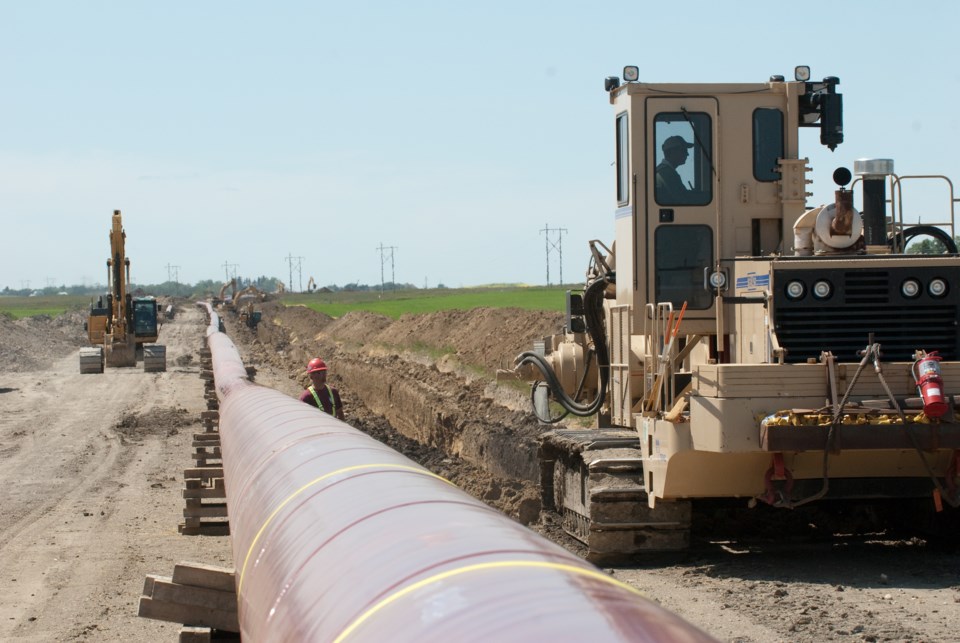Premier Brad Wall hit the nail on the head going into the mid-July premier’s conference when he said, “Maybe we should send equalization payments through a pipeline to get one approved in Central Canada.”
Funny, I think we ran an editorial cartoon to that effect a while back.
That meeting concluded with some sort of national energy strategy, but whether it’s going to mean anything or not is another question.
Here’s an energy strategy for you: Canada needs more pipelines. They have been tied up in such red tape in recent years, you would think we forgot how to do it.
Consider this: if Western Canadian oil was reaching tidewater on both the West Coast and East Coast in significant volumes, maybe we’d be getting a better price for our oil. On July 17, WTI was trading for $50.92 per barrel, but Brent (ocean-borne oil) was getting $57.51 per barrel.
The Energy East pipeline is probably the most significant of them all. Not only is it the largest proposal in terms of length (4,600 kilometres), has the most already in the ground (3,000 kilometres), and largest capacity (1.1 million barrels per day), it has the most strategic impact. Turning open the valve on that pipeline would allow Eastern Canada to use Western Canadian oil, chasing out most, if not all imports.
That would make us truly energy independent. Right now, much of Eastern Canada relies on foreign oil, while Western Canada sells its oil at a discount to a flooded U.S. market. But what if a war cuts off that oil fuelling the East? Or an embargo? What then? Our only alternative would be massive amounts of crude-by-rail shipments.
Most of Energy East is already in the ground, save the portion that will run through Quebec and New Brunswick, both have-not provinces. Ever notice that the have provinces these days produce oil and gas in substantial quantities, but provinces like Manitoba and Quebec, with their ample hydro power supplies, are have-nots? What’s the matter, cheap hydro not paying the bills?
Yet these provinces seem mighty righteous when talking about the environment. Flooding vast swaths of pristine territory is just fine, as long as it’s in the north where only First Nations people notice, apparently. But drilling for oil or gas, ooooo, that’s bad.
(A side note: Manitoba’s premier Greg Selinger seems to have, once again, forgotten he, too, has an oilpatch. “We needed a strategy to move Canada forward,” he told CBC Radio’s��The House. “At the time, a lot of people said it was impossible. It’s not an easy issue for (oil-producing provinces), but they’re showing an interest. We have to encourage them to be part of the solution.”)
Quebec may very well have natural gas. Ditto for New Brunswick. But they don’t like fracking. So it’s okay for them to cash the equalization cheques provided by fracking, but not to allow that to happen in their jurisdictions.
There’s one more thing to consider. If Energy East was in operation already, the chances of crude oil С����Ƶ shipped by rail through Quebec would be next to nothing. Energy East, with its associated Upland pipeline, would likely preclude all further crude-by-rail shipments to New Brunswick originating in Western Canada or North Dakota. If it had been operating two years ago, perhaps the Lac-Mégantic disaster might have never happened.
The answer is simple: our national energy strategy needs more pipelines. As a whole the nation will earn more for its oil, will become energy independent, and it will all be done in a much safer manner. What more do you want?
��
Clarification:
In a few pieces in recent months I have alluded to Crescent Point Energy Corp.’s share of Saskatchewan oil production as С����Ƶ close to one-third of Saskatchewan’s total oil production. In fact, that number is very close to one quarter, as Crescent Point has more American production than I had thought. With the recent acquisition of Legacy Oil+Gas, Crescent Point produces around 130,000 barrels per day in Saskatchewan. The most recent number I have for total daily production in Saskatchewan is 525,000 barrels per day. Husky produces a little less than Crescent Point, but not much. The net result is that Crescent Point and Husky, combined, produce nearly one half of all Saskatchewan oil. The rest is produced by roughly 580 other companies. I apologize for the error.
Brian Zinchuk is editor of Pipeline News. He can be reached at [email protected]




